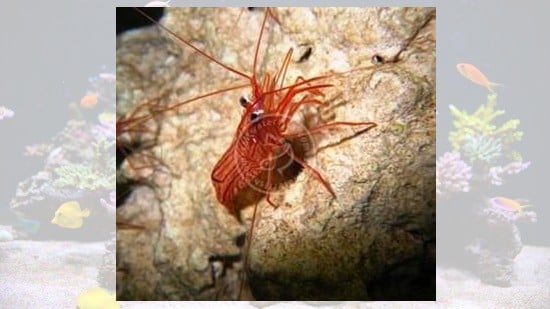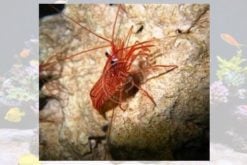Peppermint Shrimp (Lysmata wurdemanni)
Quick Stats:
- Care Level: Easy
- Temperament: Peaceful
- Diet: Omnivore
- Reef Safe: Yes
- Minimum Tank Size: 10 gallons
- Maximum Size: Up to 2 inches
- Water Parameters: pH 8.1-8.4, Salinity 1.023-1.025, Temperature 72-78°F
Comprehensive Guide to Peppermint Shrimp (Lysmata wurdemanni)
Habitat: Peppermint Shrimp, also known as Lysmata wurdemanni or Lysmata boggessi, are native to the Caribbean Sea and the Gulf of Mexico. They can be found in shallow reefs and seagrass beds.
Reef Safe: Peppermint Shrimp are generally considered reef safe as they do not harm corals or other invertebrates. In fact, they are often sought after for their ability to eat unwanted pests in reef aquariums, such as Aiptasia anemones.
Reef Cleaner: Peppermint Shrimp are known to be effective at controlling populations of Aiptasia anemones, which can be problematic in reef tanks. They will actively seek out and consume these pests, making them a valuable addition to a reef aquarium.
Size: Peppermint Shrimp typically grow up to 2 inches in length, making them a relatively small species suitable for most saltwater aquariums.
Sexual Dimorphism: It can be challenging to differentiate between male and female Peppermint Shrimp visually. However, females tend to be slightly larger and have a rounder abdomen when carrying eggs.
Lifespan: In optimal conditions, Peppermint Shrimp can live for 2-3 years in captivity.
Diet in Aquariums: Peppermint Shrimp are omnivores and will accept a variety of foods. They primarily feed on small invertebrates, detritus, and algae. It’s recommended to provide a balanced diet consisting of quality pellet or flake food, supplemented with occasional live or frozen foods like brine shrimp or mysis shrimp.
Aquacultured Availability: Peppermint Shrimp are commonly aquacultured, meaning they are bred in captivity rather than collected from the wild. This makes them readily available to hobbyists and helps reduce pressure on wild populations.
Compatibility: Peppermint Shrimp are generally peaceful and can coexist with a wide range of fish, invertebrates, and corals. However, caution should be exercised when keeping them with predatory or aggressive species. Here are five popular tankmates for Peppermint Shrimp:
- Clownfish: Clownfish are known to form symbiotic relationships with anemones, and Peppermint Shrimp can help control any unwanted Aiptasia anemones that may appear.
- Firefish: Firefish are peaceful and colorful, making them a great addition to a community tank. They usually don’t pose any threat to Peppermint Shrimp.
- Gobies: Gobies are small, peaceful fish that can coexist with Peppermint Shrimp. They often share similar habitat preferences.
- Soft Corals: Peppermint Shrimp are generally compatible with various soft corals, such as Zoanthids and Mushroom Corals. They won’t harm these corals and may even help keep the tank clean.
- Snails: Peppermint Shrimp can peacefully coexist with various snail species, which can help with algae control and tank maintenance.
Temperament: Peppermint Shrimp have a peaceful temperament and are generally non-aggressive towards other tank inhabitants. However, they may become territorial if their hiding spaces are invaded.
Other Common Names: Peppermint Shrimp are also known as Caribbean Cleaner Shrimp or Veined Shrimp.
Why Buy from Reefs4Less.com: Reefs4Less.com is a reputable online retailer known for providing high-quality saltwater aquarium livestock and supplies. They offer a wide selection of Peppermint Shrimp and ensure the health and well-being of their livestock through proper handling and shipping practices.
Popular Questions about Peppermint Shrimp (Lysmata wurdemanni) in Saltwater Aquariums:
-
- Q: Are Peppermint Shrimp suitable for beginners?
A: Yes, Peppermint Shrimp are considered suitable for beginners as they are relatively easy to care for and can help control unwanted pests in the aquarium.
-
- Q: Can Peppermint Shrimp be kept in a reef tank?
A: Yes, Peppermint Shrimp are reef safe and can be kept in a reef tank without causing harm to corals or other invertebrates.
-
- Q: How often should I feed Peppermint Shrimp?
A: Peppermint Shrimp should be fed once or twice a day, offering a variety of foods to ensure a balanced diet.
-
- Q: Can Peppermint Shrimp be kept with aggressive fish?
A: It’s generally not recommended to keep Peppermint Shrimp with aggressive or predatory fish, as they may become targets or be stressed by constant harassment.
-
- Q: Do Peppermint Shrimp require a specific water flow in the aquarium?
A: Peppermint Shrimp can tolerate a range of water flow conditions, but moderate to high flow is generally preferred to simulate their natural habitat.




Reviews
There are no reviews yet.